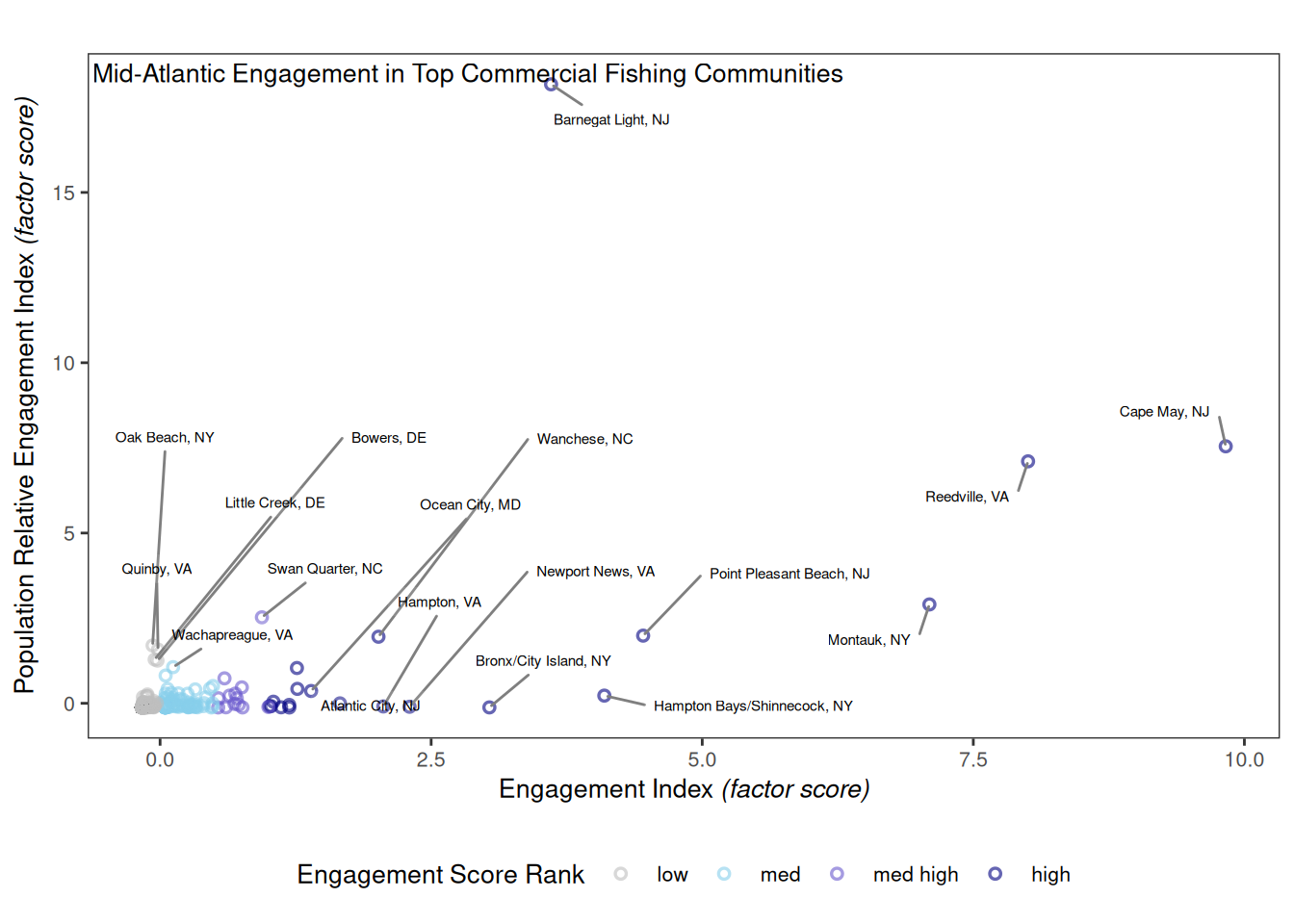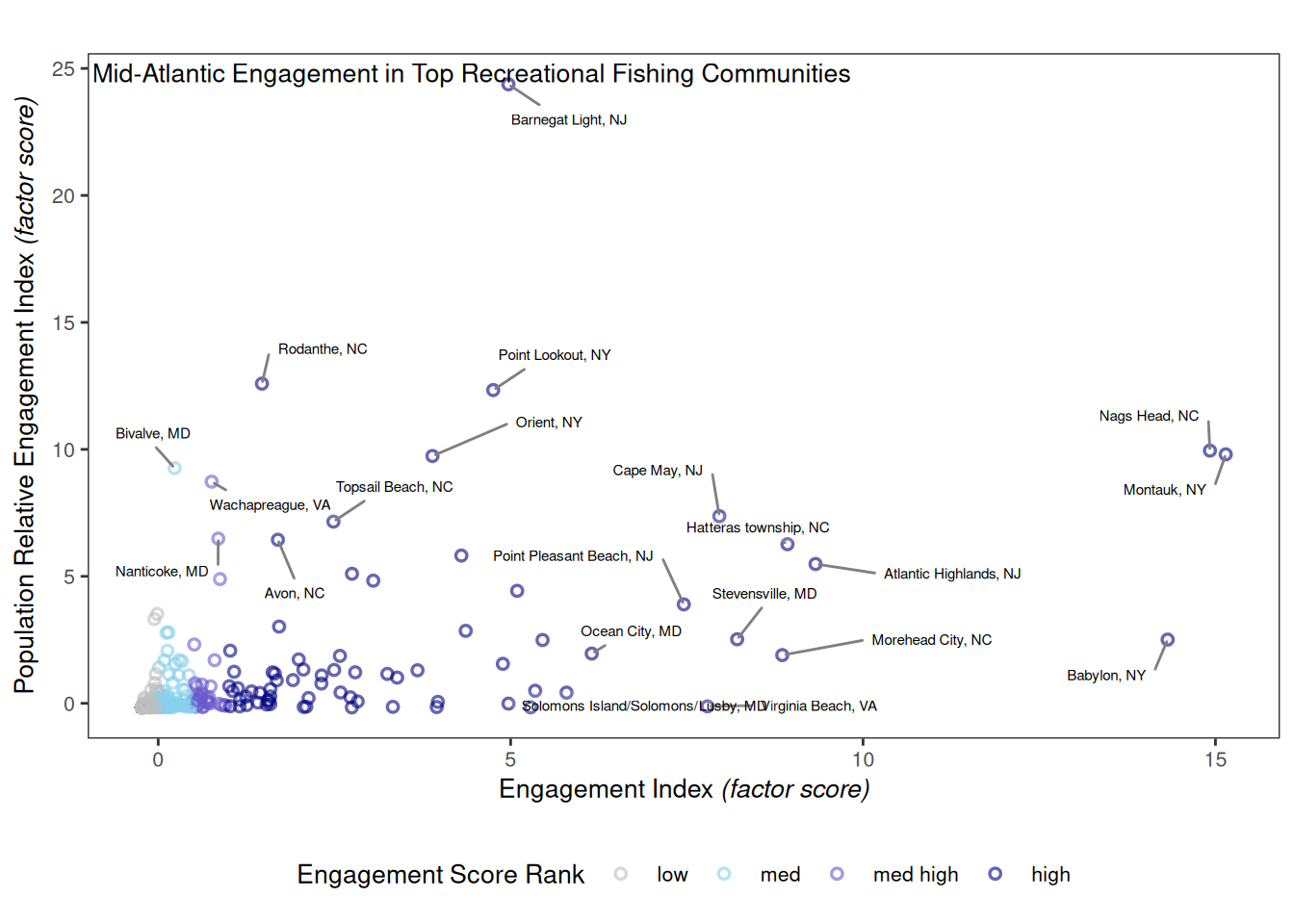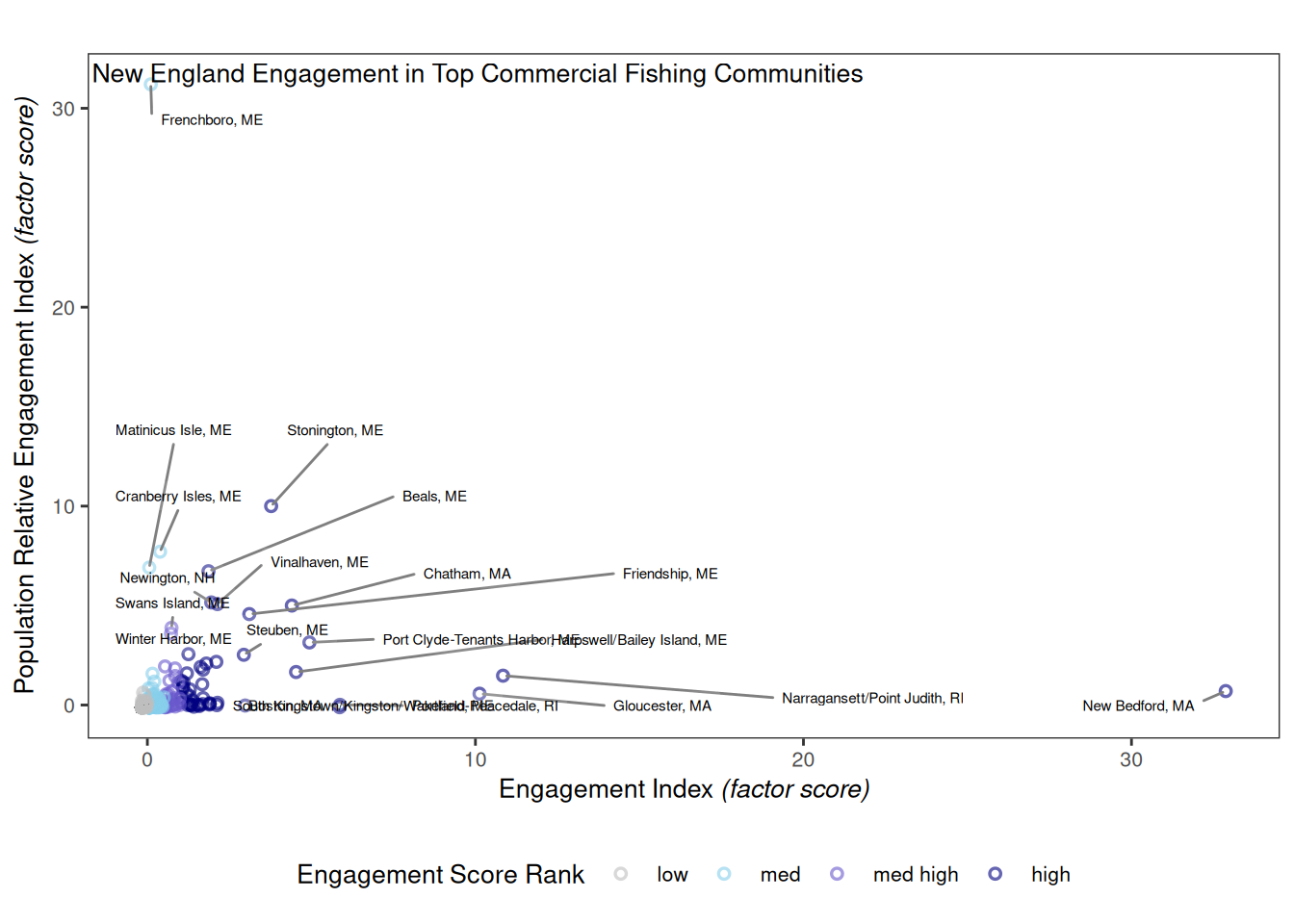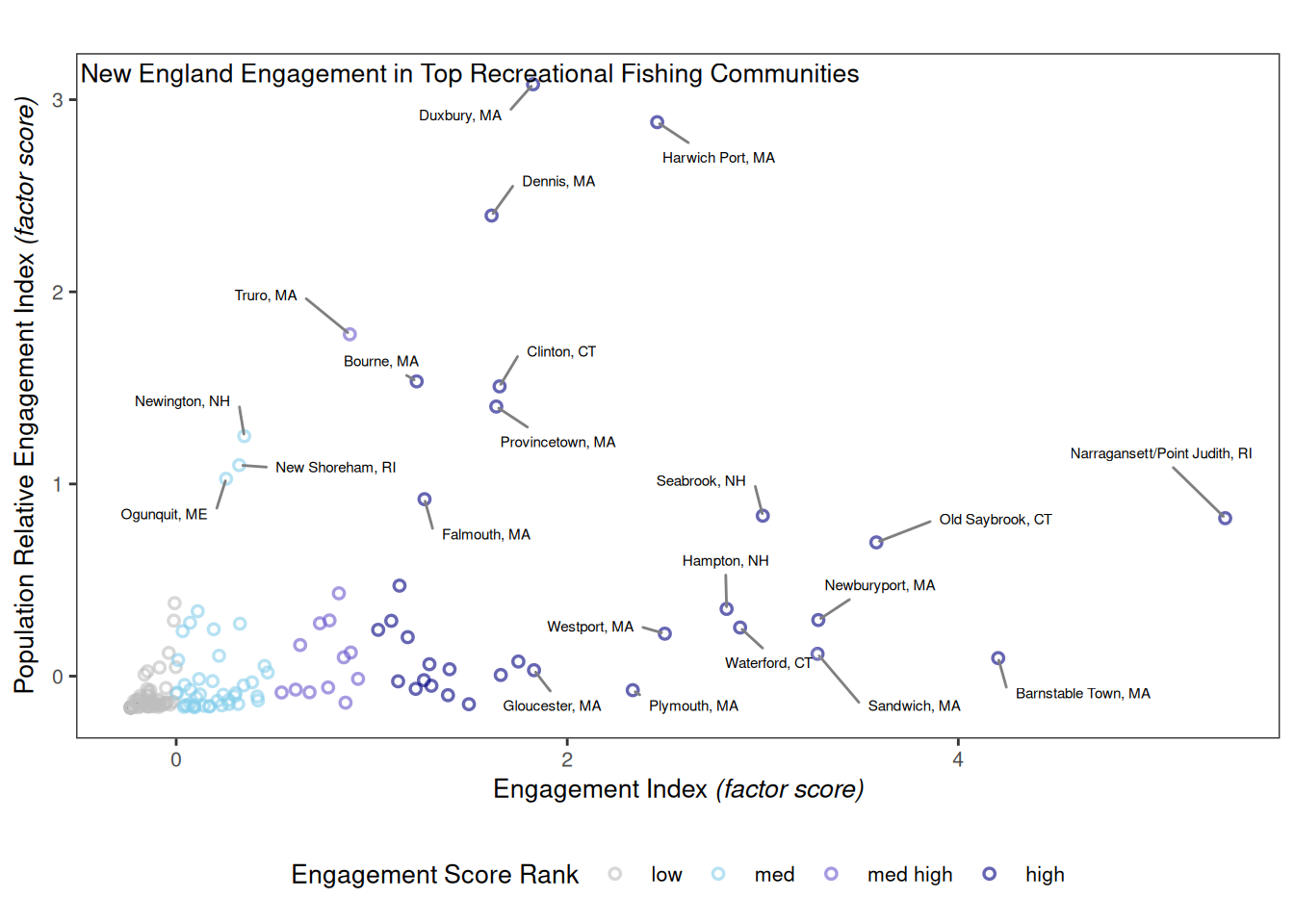73 Community Social Vulnerability Indicators (CSVI)
Description: The data presented here are 2022 community social vulnerability indicators in top commercial and top recreational communities in Mid-Atlantic and New England regions.
Indicator family:
Contributor(s): Robert Murphy, Changhua Weng, Tanya Noteva
Affiliations: NEFSC
73.1 Introduction to Indicator
We report the top ten communities most engaged in (both in an absolute and relative sense) commercial and recreational fisheries and the degree to which these communities may be vulnerable to change based on their socio-demographic conditions (i.e., poverty index, population composition index, and personal disruption index) using data for the most recent available year (2022).
The engagement indices demonstrate the importance of commercial and recreational fishing to a given community relative to other coastal communities in a region. In particular, the commercial fishing engagement index measures the number of permits and dealers, and pounds and value of fish landed in a community. Recreational fishing engagement measures shore, private vessel, and for-hire fishing effort. Population relative engagement indices express these numbers based on fishing effort relative to the population of a community. Note that we recast commercial and recreational reliance indicators (from previous reports) as relative engagement indicators given that they are a proxy for how engaged each community is in fishing relative to its total population size and many more factors ultimately contribute to a fishing community’s reliance on fishing. Importantly, the calculation of these indicators remains the same.
Social vulnerability indicators measure social factors that shape a community’s ability to adapt to change. These are derived from the NOAA Fisheries Community Social Vulnerability Indicators (CSVIs) which characterize aspects of well-being for coastal communities engaged in fishing activities. Three of the existing NOAA CSVIs - the poverty index, population composition Index, and personal disruption Index - can be used to specifically examine key aspects of socio-demographic conditions. The personal disruption index includes several variables that aim characterize factors that may make it particularly challenging to respond to change because of personal circumstances affecting family life such as unemployment or educational level. The poverty index includes different metrics of poverty (e.g., families below poverty level and percent receiving cash public assistance income) such that a high score would indicate a community with a lower financial standing relative to other communities. The population composition index characterizes socio-demographic groups within communities that are traditionally thought to be increasingly vulnerable to change such as non-English speakers and female heads of households.
For this report, we selected the top ten communities with the highest engagement scores, the top ten communities with the highest population relative engagement scores, and focused on three socio-demographic indicators within the CSVI toolset (poverty, personal disruption, population composition). Sometimes, a community will appear on both lists (i.e., top ten highest engagement AND population relative engagement scores) such that the total report top communities will sum to less than 20. Here we apply the same selection standard for top fishing communities for both sectors using 2022 data, and again examine several CSVIs in this updated set of communities.
73.2 Key Results and Visualizations
73.2.0.1 Mid Atlantic
In 2022, several communities stood out as having a particularly high engagement in commercial fishing including Cape May, NJ; Reedville, VA; and Montauk, NY. Additionally, Barnegat Light, NJ is much more engaged in commercial fishing relative to its population size when compared to other communities in the Mid-Atlantic. Cape May, NJ also ranked medium on the population composition index (calculated based on proportions of non-white, non-English speaking, and younger populations), suggesting that this important commercial fishing community may be more vulnerable to change in the future. Several other top ranked commercial fishing communities have socio-demographic concerns that could predispose these places to increased impacts including Little Creek, DE; Hampton, VA; Newport News, VA; Bronx/City Island, NY; Quinby, VA; Point Pleasant Beach, NJ; and Hampton Bays/Shinnecock, NY.
Barnegat Light, NJ also stood out as being much more engaged in recreational fishing relative to its population size when compared to other communities in the Mid-Atlantic, although it did not rank medium or higher on the socio-demographic indices. Of those included in the top-ranked recreational communities, both Bivalve, MD and Morehead City, NC had medium or higher ranks for two of three socio-demographic indicators examined here (poverty, personal disruption, population composition). This suggests that future changes to recreational fishing conditions may disproportionately affect these places. Two other top recreational fishing communities had ranked medium or high for one socio-demographic index: Stevensville, MD and Cape May, NJ.
Several communities ranked in the top communities for both commercial and recreational indices; Montauk, NY, Cape May, Barnegat Light, NJ: and Point Pleasant Beach, NJ; meaning these communities may be impacted simultaneously (to a greater degree than others) by commercial and recreational regulatory and ecosystem changes.
73.2.0.2 New England
In 2022, New Bedford, MA stands out as having a particularly high engagement in commercial fishing, while Frenchboro, ME is much more engaged in commercial fishing relative to its population size when compared to other communities in the Northeast. Of particular concern among top commercial fishing communities are New Bedford and Boston, MA as they both have medium or higher scores for all three socio-demographic indicators, while Port Clyde-Tenants Harbor, ME ranked medium for two of the three indicators. Swans Island, ME - another top ranked commercial fishing community -ranked medium on the personal disruption index suggesting that circumstances affecting family life like unemployment or educational level may result in increased vulnerability.
Duxbury, MA was the most engaged place in recreational fishing relative to its population size when compared to other communities in New England, followed closely by Harwich Port, MA, although neither ranked medium or higher on the socio-demographic indices. Of those included in the top ranked recreational communities, only Provincetown, MA had medium or higher ranks for more than one socio-demographic indicator examined. This suggests that future changes to recreational fishing conditions may disproportionately affect Provincetown. Three other top recreational fishing communities ranked medium or high for one socio-demographic index: New Shoreham, RI; Seabrook, NH; and Barnstable Town, MA.
Narragansett/Point Judith, RI ranked as a top community for both commercial and recreational indices, suggesting that it may be impacted simultaneously (to a greater degree than others) by commercial and recreational regulatory changes
73.2.1 MidAtlantic

Community |
personal_disruption_rank |
pop_composition_rank |
poverty_rank |
|---|---|---|---|
Cape May, NJ |
low |
med |
low |
Reedville, VA |
low |
low |
low |
Montauk, NY |
low |
low |
low |
Point Pleasant Beach, NJ |
med |
low |
low |
Hampton Bays/Shinnecock, NY |
low |
high |
low |
Barnegat Light, NJ |
low |
low |
low |
Bronx/City Island, NY |
high |
high |
high |
Newport News, VA |
med |
low |
med |
Hampton, VA |
med |
low |
med |
Wanchese, NC |
low |
low |
low |
Atlantic City, NJ |
high |
high |
high |
Ocean City, MD |
med |
low |
low |
Swan Quarter, NC |
low |
low |
low |
Wachapreague, VA |
low |
low |
low |
Quinby, VA |
med |
low |
low |
Bowers, DE |
low |
low |
low |
Little Creek, DE |
high |
low |
high |
Oak Beach, NY |
low |
low |
Community |
labor_force_str_rank |
housing_characteristics_rank |
|---|---|---|
Cape May, NJ |
med high |
med |
Reedville, VA |
high |
|
Montauk, NY |
med |
low |
Point Pleasant Beach, NJ |
low |
low |
Hampton Bays/Shinnecock, NY |
low |
low |
Barnegat Light, NJ |
high |
|
Bronx/City Island, NY |
low |
med |
Newport News, VA |
low |
med high |
Hampton, VA |
low |
med |
Wanchese, NC |
low |
high |
Atlantic City, NJ |
med |
med high |
Ocean City, MD |
low |
med high |
Swan Quarter, NC |
med high |
|
Wachapreague, VA |
high |
med |
Quinby, VA |
high |
|
Bowers, DE |
high |
med high |
Little Creek, DE |
low |
med high |
Oak Beach, NY |
low |
Community |
housing_disrupt_rank |
retiree_migration_rank |
urban_sprawl_index_rank |
|---|---|---|---|
Cape May, NJ |
high |
med high |
low |
Reedville, VA |
med |
high |
|
Montauk, NY |
high |
med |
med high |
Point Pleasant Beach, NJ |
high |
med |
med high |
Hampton Bays/Shinnecock, NY |
high |
med |
med high |
Barnegat Light, NJ |
med high |
high |
med high |
Bronx/City Island, NY |
med |
low |
high |
Newport News, VA |
low |
low |
low |
Hampton, VA |
low |
low |
low |
Wanchese, NC |
low |
low |
low |
Atlantic City, NJ |
low |
low |
low |
Ocean City, MD |
low |
med |
low |
Swan Quarter, NC |
med high |
low |
|
Wachapreague, VA |
med |
high |
low |
Quinby, VA |
med |
low |
|
Bowers, DE |
med |
high |
low |
Little Creek, DE |
med |
low |
low |
Oak Beach, NY |
med high |

Community |
personal_disruption_rank |
pop_composition_rank |
poverty_rank |
|---|---|---|---|
Cape May, NJ |
low |
med |
low |
Montauk, NY |
low |
low |
low |
Point Pleasant Beach, NJ |
med |
low |
low |
Barnegat Light, NJ |
low |
low |
low |
Ocean City, MD |
med |
low |
low |
Virginia Beach, VA |
low |
low |
low |
Morehead City, NC |
med |
low |
med |
Hatteras township, NC |
low |
low |
low |
Wachapreague, VA |
low |
low |
low |
Avon, NC |
high |
low |
|
Atlantic Highlands, NJ |
low |
low |
low |
Babylon, NY |
low |
low |
low |
Nags Head, NC |
low |
low |
low |
Point Lookout, NY |
low |
low |
low |
Nanticoke, MD |
med high |
low |
low |
Orient, NY |
low |
low |
|
Bivalve, MD |
med |
high |
|
Rodanthe, NC |
low |
low |
|
Topsail Beach, NC |
low |
low |
low |
Solomons Island/Solomons/Lusby, MD |
low |
low |
low |
Stevensville, MD |
med |
low |
low |
Community |
labor_force_str_rank |
housing_characteristics_rank |
|---|---|---|
Cape May, NJ |
med high |
med |
Montauk, NY |
med |
low |
Point Pleasant Beach, NJ |
low |
low |
Barnegat Light, NJ |
high |
|
Ocean City, MD |
low |
med high |
Virginia Beach, VA |
low |
low |
Morehead City, NC |
med |
med high |
Hatteras township, NC |
low |
med high |
Wachapreague, VA |
high |
med |
Avon, NC |
med |
|
Atlantic Highlands, NJ |
low |
low |
Babylon, NY |
low |
low |
Nags Head, NC |
med high |
med high |
Point Lookout, NY |
high |
low |
Nanticoke, MD |
low |
|
Orient, NY |
high |
low |
Bivalve, MD |
high |
|
Rodanthe, NC |
low |
|
Topsail Beach, NC |
high |
med |
Solomons Island/Solomons/Lusby, MD |
low |
low |
Stevensville, MD |
low |
low |
Community |
housing_disrupt_rank |
retiree_migration_rank |
urban_sprawl_index_rank |
|---|---|---|---|
Cape May, NJ |
high |
med high |
low |
Montauk, NY |
high |
med |
med high |
Point Pleasant Beach, NJ |
high |
med |
med high |
Barnegat Light, NJ |
med high |
high |
med high |
Ocean City, MD |
low |
med |
low |
Virginia Beach, VA |
low |
low |
low |
Morehead City, NC |
med |
med |
low |
Hatteras township, NC |
low |
low |
low |
Wachapreague, VA |
med |
high |
low |
Avon, NC |
low |
low |
|
Atlantic Highlands, NJ |
med |
low |
med |
Babylon, NY |
med high |
low |
high |
Nags Head, NC |
low |
high |
low |
Point Lookout, NY |
med high |
med high |
high |
Nanticoke, MD |
high |
||
Orient, NY |
high |
high |
med |
Bivalve, MD |
high |
||
Rodanthe, NC |
low |
low |
|
Topsail Beach, NC |
low |
high |
|
Solomons Island/Solomons/Lusby, MD |
low |
low |
med |
Stevensville, MD |
med |
low |
med |
73.2.2 NewEngland

Community |
personal_disruption_rank |
pop_composition_rank |
poverty_rank |
|---|---|---|---|
New Bedford, MA |
med high |
high |
med high |
Narragansett/Point Judith, RI |
low |
low |
low |
Gloucester, MA |
low |
low |
low |
Portland, ME |
low |
low |
low |
Boston, MA |
med |
high |
med high |
Port Clyde-Tenants Harbor, ME |
med |
low |
med |
Harpswell/Bailey Island, ME |
low |
low |
low |
Chatham, MA |
low |
low |
low |
Stonington, ME |
low |
low |
low |
Friendship, ME |
low |
low |
low |
South Kingstown/Kingston/Wakefield-Peacedale, RI |
low |
low |
low |
Steuben, ME |
low |
low |
low |
Vinalhaven, ME |
low |
low |
low |
Newington, NH |
low |
low |
low |
Beals, ME |
low |
low |
low |
Swans Island, ME |
med |
low |
low |
Winter Harbor, ME |
low |
low |
low |
Cranberry Isles, ME |
low |
low |
low |
Frenchboro, ME |
low |
low |
|
Matinicus Isle, ME |
low |
low |
low |
Community |
labor_force_str_rank |
housing_characteristics_rank |
|---|---|---|
New Bedford, MA |
low |
med high |
Narragansett/Point Judith, RI |
med |
low |
Gloucester, MA |
low |
low |
Portland, ME |
low |
med |
Boston, MA |
low |
low |
Port Clyde-Tenants Harbor, ME |
high |
med |
Harpswell/Bailey Island, ME |
med |
med |
Chatham, MA |
high |
low |
Stonington, ME |
med |
med high |
Friendship, ME |
med high |
med high |
South Kingstown/Kingston/Wakefield-Peacedale, RI |
med |
med |
Steuben, ME |
low |
high |
Vinalhaven, ME |
high |
med high |
Newington, NH |
med |
low |
Beals, ME |
low |
high |
Swans Island, ME |
low |
|
Winter Harbor, ME |
high |
med high |
Cranberry Isles, ME |
low |
|
Frenchboro, ME |
low |
|
Matinicus Isle, ME |
high |
Community |
housing_disrupt_rank |
retiree_migration_rank |
urban_sprawl_index_rank |
|---|---|---|---|
New Bedford, MA |
med |
low |
med high |
Narragansett/Point Judith, RI |
med high |
med |
low |
Gloucester, MA |
med |
low |
med |
Portland, ME |
med high |
low |
med |
Boston, MA |
high |
low |
high |
Port Clyde-Tenants Harbor, ME |
med |
high |
low |
Harpswell/Bailey Island, ME |
med |
med high |
low |
Chatham, MA |
high |
high |
med |
Stonington, ME |
high |
med |
low |
Friendship, ME |
low |
high |
low |
South Kingstown/Kingston/Wakefield-Peacedale, RI |
med |
med |
low |
Steuben, ME |
low |
low |
low |
Vinalhaven, ME |
high |
high |
low |
Newington, NH |
med high |
med |
med |
Beals, ME |
med |
low |
low |
Swans Island, ME |
med |
low |
low |
Winter Harbor, ME |
low |
high |
low |
Cranberry Isles, ME |
low |
low |
low |
Frenchboro, ME |
high |
low |
|
Matinicus Isle, ME |
high |
high |

Community |
personal_disruption_rank |
pop_composition_rank |
poverty_rank |
|---|---|---|---|
Narragansett/Point Judith, RI |
low |
low |
low |
Gloucester, MA |
low |
low |
low |
Newington, NH |
low |
low |
low |
Barnstable Town, MA |
low |
med |
low |
Westport, MA |
low |
low |
low |
Plymouth, MA |
low |
low |
low |
Hampton, NH |
low |
low |
low |
Sandwich, MA |
low |
low |
low |
Provincetown, MA |
low |
med |
med high |
Seabrook, NH |
med |
low |
low |
Duxbury, MA |
low |
low |
low |
Harwich Port, MA |
low |
low |
low |
Truro, MA |
low |
low |
low |
Bourne, MA |
low |
low |
low |
New Shoreham, RI |
med |
low |
low |
Newburyport, MA |
low |
low |
low |
Dennis, MA |
low |
low |
low |
Falmouth, MA |
med |
low |
med high |
Ogunquit, ME |
low |
low |
low |
Waterford, CT |
low |
low |
low |
Old Saybrook, CT |
low |
low |
low |
Clinton, CT |
low |
low |
low |
Community |
labor_force_str_rank |
housing_characteristics_rank |
|---|---|---|
Narragansett/Point Judith, RI |
med |
low |
Gloucester, MA |
low |
low |
Newington, NH |
med |
low |
Barnstable Town, MA |
low |
low |
Westport, MA |
low |
med |
Plymouth, MA |
low |
low |
Hampton, NH |
low |
low |
Sandwich, MA |
low |
low |
Provincetown, MA |
low |
med |
Seabrook, NH |
med |
med high |
Duxbury, MA |
low |
|
Harwich Port, MA |
med high |
med |
Truro, MA |
med high |
|
Bourne, MA |
high |
med |
New Shoreham, RI |
med high |
low |
Newburyport, MA |
low |
low |
Dennis, MA |
high |
low |
Falmouth, MA |
high |
med |
Ogunquit, ME |
high |
low |
Waterford, CT |
low |
med |
Old Saybrook, CT |
low |
low |
Clinton, CT |
low |
med |
Community |
housing_disrupt_rank |
retiree_migration_rank |
urban_sprawl_index_rank |
|---|---|---|---|
Narragansett/Point Judith, RI |
med high |
med |
low |
Gloucester, MA |
med |
low |
med |
Newington, NH |
med high |
med |
med |
Barnstable Town, MA |
med |
low |
|
Westport, MA |
med |
med |
med |
Plymouth, MA |
med |
med |
med |
Hampton, NH |
low |
med |
med |
Sandwich, MA |
med |
med |
low |
Provincetown, MA |
med |
low |
med |
Seabrook, NH |
low |
med |
med |
Duxbury, MA |
low |
low |
high |
Harwich Port, MA |
low |
high |
low |
Truro, MA |
low |
high |
low |
Bourne, MA |
low |
high |
low |
New Shoreham, RI |
med |
med high |
med high |
Newburyport, MA |
med high |
low |
med high |
Dennis, MA |
med high |
high |
low |
Falmouth, MA |
med high |
high |
med |
Ogunquit, ME |
med |
high |
low |
Waterford, CT |
low |
low |
|
Old Saybrook, CT |
med |
med |
|
Clinton, CT |
low |
med |
low |
73.3 Indicator statistics
Spatial scale: Communities located in marine coastal counties in the U.S.
Temporal scale: Year of 2022
Synthesis Theme:
73.4 Implications
These indicators provide a snapshot of the presence of socio-demographic concerns in the most highly engaged commercial and recreational fishing communities in the Mid-Atlantic and New England. These communities may be especially vulnerable to changes in fishing patterns due to regulations and/or ecosystem changes. Many of these communities, especially top commercial fishing communities, demonstrated medium to high vulnerability indicating that they may be at a disadvantage responding to change.
73.5 Get the data
Point of contact: Robert Murphy (robert.murphy@noaa.gov)
ecodata name: ecodata::engagement
Variable definitions
- Name: Community Name: name of the community.
- Commercial Engagement Index: commercial engagement factor score.
- Commercial Relative Engagement Index: commercial relative engagement factor score.
- Recreational Engagement Score: recreational engagement factor score.
- Recreational Relative Engagement Index: recreational relative engagement factor score.
- Social vulnerabilities: categorical rankings of social vulnerability.
- Personal Disruption Index: personal disruption factor score.
- Population Composition Index: population composition factor score.
- Poverty Index: poverty index factor score. 10) 1 std: 1 standard deviation.
- 0.5 std: 0.5 standard deviation.
Indicator Category:
73.7 Accessibility and Constraints
No response
tech-doc link https://noaa-edab.github.io/tech-doc/engagement.html